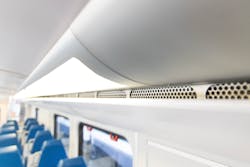A Tried-and-True Solution Makes its Debut in the Public Transit Industry
State-of-the-art air purification systems and air filters are not new technology; they’ve been used to scrub germs, microbes, viruses and bacteria from the air and surfaces in airplanes, government buildings and hospital settings. But the application of this technology on transit vehicles is just now starting to be explored as transit agencies search for new solutions to maintain a safe environment for passengers and operators as the world grapples with the COVID-19 pandemic.
Now that agencies are testing and installing these systems, companies are expanding their product offerings to provide cleaner air for the community.
Oahu Transit Services Pilots Two Different Systems
“It seemed a little too good to be true at first, but the more research [we did], we found it was an existing technology and there were a lot of studies on it that backed their claims, so we decided to test [both systems] on our buses,” said Adam Tamayoshi, vice president of maintenance, Oahu Transit Services (OTS).
OTS is currently piloting United Safety & Suvivability Corp.’s (USSC) Active Air Purification with RGF Photohydroionization® PHI Technology and NFI Parts’ Proactive Air and Surface Purification (PASP) system. USSC’s system uses safe levels of naturally occurring hydroperoxides to kill germs, microbes, viruses and bacteria in the air and on surfaces and is installed in the existing HVAC system. NFI Parts' PASP technology creates High Energy Clusters (HEC) and Advanced Bi-Polar Ion Oxidizers that destroy dangerous pathogens at the cellular level in the air and on surfaces. Air flows in to the unit creating HEC and oxidizers that leave the system which are dispersed through the vehicle by the fan inside the unit and attack pathogens in the air and on surfaces. The unit can be activated whenever the vehicle is running; it uses 12V DC power and does not draw support from the HVAC system. It is a standalone unit which easily mounts in the bus and does not void the warranty of the HVAC system.
“The draw to [this technology] is the fact that it disinfects both air and surface and actively does it while we have riders on the bus,” Tamayoshi explained.
The systems were installed on one articulated 60-foot bus and two 40-foot buses. Both companies worked directly with OTS’ maintenance staff to ensure a smooth and successful installation, which Tamayoshi notes was pretty straightforward. Maintenance of the systems is also pretty straightforward. Since the USSC’s system is integrated with the AC system, only an annual bulb replacement is required; NFI Parts' system is standalone, which also requires an annual bulb replacement, as well as filters that are replaced quarterly. Tamayoshi adds there haven’t been any impacts or changes on the operation side.
Because USSC’s product is installed in the existing AC unit, Tamayoshi explains OTS knows it disperses well because of the airflow within the bus. He shares while OTS believes NFI Parts' standalone unit also has good dispersion, it is unclear how the product is dispersed if the AC system is not on within the bus. However, when considering the pros and cons of each system, Tamayoshi believes it depends on the ridership and how the information is shared with riders. With the standalone unit, for example, riders can actually see a light that indicates the system is working.
In addition to eliminating viruses and such within transit vehicles, Tamayoshi notes this technology also eliminates possibly harmful chemicals from cleaning solutions and disinfectants, as well as residue and odors, since the systems clean the air by mimicking the natural process that happens outdoors. If OTS chooses to move forward with either of these systems, Tamayoshi says he believes the agency will be able to eliminate the cost of contracting out to have the vehicles disinfected.
Tamayoshi expects the agency will be ready to make a decision mid-February about whether or not to implement this technology once it receives official third-party lab results, which OTS is working on with NFI Parts.
“Should the results of the third-party lab come back and show very positive results, I believe that that would be sufficient enough for [me] to make a formal recommendation and large push to the city to consider this,” Tamayoshi said. “I would hope that we try to make some kind of push to have these installed on not only our buses but also our paratransit vehicles.”
Green Bay Metro Moves Full Steam Ahead
Green Bay Metro, similar to many other agencies, implemented a vigorous cleaning regiment that included nightly cleanings of all buses through what Patty Kiewiz, transit director for the city of Green Bay, Wis., calls a cleaning “bomb.” However, this process puts the buses out of commission for about six hours, and with a fleet of 36 buses, Kiewiz was eager to find a cleaning solution that was more practical. The new solution needed to have minimal impact on operations while being something that was manageable and feasible for the agency to maintain.
Fast forward to December 2020 and Green Bay Metro utilized a portion of its $6.4 million from the CARES Act to fund the installation of USSC’s air purification system on its entire fleet of buses, making it the first transit agency in the United States to have this technology on every vehicle. Although there are numerous purification systems on the market, Kiewiz says USSC’s product was the “best fit for our system.”
“One of the things that was kind of big for us with this system was the fact that we didn’t have any strong odors or chemicals,” Kiewiz said.
Another key feature, albeit a small feature, are the two green lights that turn on to signal the system is working properly. This tells both the staff and the public the system is functioning and there’s an added level of safety within the vehicle.
USSC also worked with Green Bay Metro’s maintenance team to install the systems. Since the agency has various buses, some of the air purification systems are mounted in the rear while others are mounted on top of the bus—depending on the location of the HVAC system. In all, it took about two to three months from the time Green Bay Metro decided on its initial system to it being installed throughout the bus fleet.
Similar to OTS, Kiewiz reports staff haven’t encountered any maintenance issues and the purification systems have had no impacts to operations. What may change thanks to these systems, however, is the limited capacity Green Bay Metro has in place to bolster social distancing guidelines. With all these benefits associated with this technology, Kiewiz can’t help but think Green Bay Metro should’ve done this “a long time ago.”
“[I was] a little jealous that it’s taken this long for [the transit industry] to get this technology,” Kiewiz said when explaining the various places this technology has already been implemented, “[but] this is something we are very happy with and will continue to install in our fleet.”
Metrolink Increases Air Quality with Coated Filters
Eric Hosey, chief operating officer, Metrolink, explains at the beginning of the pandemic, he and the mechanical group brainstormed different solutions aimed at better circulating clean air within the interior of rail cars. The agency already had HVAC systems, which included air filters, to moderate temperatures in the cars, but Metrolink was interested in something that would purify the air on a constant basis in tandem with the HVAC systems.
After some trial and error of testing out different MERV ratings, the thickness of an air filter and what it can do, Metrolink decided to go with PuraShield’s Purafil filter, which has a MERV rating of eight—the same rating of the previous filters. Hosey explains filters the agency tested prior had higher MERV ratings, such as 13, that would restrict the air flow too much, especially in the hotter months when the rail cars needed to be kept cooler. He notes the difference with the Purafil filters is that they are coated with copper and silver ions, which kills viruses on contact when it scrubs the air. And not only does it scrub the air but it also keeps up the efficiency of the HVAC systems Metrolink currently has.
Just like the other two agencies, Metrolink had no issue with installing the PuraShield filters, particularly because it was a part of the current maintenance program. As rail cars would come into the shop, the maintenance team would switch out the current air filters to the upgraded Purafil filters. Hosey says Metrolink is now on a 30-day rotation of when the new filters need to be changed instead of the standard quarterly rotation as part of ramped up cleaning efforts. In addition to cleaner air, Hosey reports that as far as efficiency, they’re “working really well.”
“We had been concerned that a mitigating solution might cause additional fuel usage, but this has not occurred,” Hosey said.
Metrolink also used a portion of CARES Act funding and a portion of its operating budget to help pay for this project. The Purafil filters have been in use for almost two months now with no signs of them breaking down. Looking to the months ahead, and a future of post-COVID-19, Hosey says these filters are something worth sticking with, especially when it comes to giving riders and staff a peace of mind that the environment is clean.
“We thought we were doing good, we can always do better,” Hosey said. “[We want to] provide circulated air that’s cleaner than it ever was before. Those are the things we really need to think about.”
Same Technology, New Applications
Tamayoshi, Kiewiz and Hosey all agree they had either not heard of this technology prior to COVID-19 or did not consider how it could be used within a public transit setting. But what they also agree on are the benefits these systems and filters provide.
“This is something brand new,” Tamayoshi said. “We weren’t aware that this was a technology currently being used in [transit] facilities on the mainland at all, [and] it is quite interesting this technology hasn’t been more popular during this time. But the more agencies feel confident going forward with the technology, the more other agencies may be willing to follow. And anything we can do to make our riders and our drivers feel safer out there during this time can only benefit everyone.”
About the Author
Megan Perrero
Editor in Chief
Megan Perrero is a national award-winning B2B journalist and lover of all things transit. Currently, she is the Editor in Chief of Mass Transit magazine, where she develops and leads a multi-channel editorial strategy while reporting on the North American public transit industry.
Prior to her position with Mass Transit, Perrero was the senior communications and external relations specialist for the Shared-Use Mobility Center, where she was responsible for helping develop internal/external communications, plan the National Shared Mobility Summit and manage brand strategy and marketing campaigns.
Perrero serves as the board secretary for Latinos In Transit and is a member of the American Public Transportation Association Marketing and Communications Committee. She holds a bachelor’s degree in multimedia journalism with a concentration in magazine writing and a minor in public relations from Columbia College Chicago.

